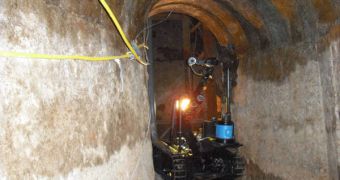The border between the United States and Mexico is one of the most assaulted in the world, as far as the number of illegal immigrants trying to push through goes. Despite the Secure Border Fence Act of 2006, with which the Congress approved the construction of 700 miles of fence between the two nations, immigrants and drugs have kept flowing into the southern US, and then have gotten spread across the country. One of the main ways in which dealers do that is through tunnels drilled underground, which are very tight and narrow, thus providing them with the best cover possible.
Sending border patrols into these dark and narrow tunnels is very dangerous, authorities say, because it's an unfamiliar and uncharted territory, where death could come ripping at every step. Therefore, when experts at the Idaho National Laboratory developed a new, special-intelligence software for outfitting bots, their innovation was welcomed by authorities. Their computer program can be mounted on a number of existing robotic platforms, and helps coordinate a number of lasers, which give the machines the ability to accurately position themselves within the tunnels, and map them at the same time.
“They are not places you want to send people, especially ones that are claustrophobic, so it’s a perfect application for robotics. That’s where we’ve really found a niche for the capabilities that we have,” INL Roboticist David Bruemmer said of the tunnels. The expert has spent the last year developing the new software, Wired reports. The need for extra protection against immigrants and drug dealers has increased significantly since the terrorist attacks of 2001, when security around the US was ramped up.
Since then, 32 tunnels were discovered in the San Diego area alone. Over the past three years, authorities in Arizona have discovered 30 tunnels as well. Before that, only a couple of such constructions had been found over an eight-year time frame. “We’ve discovered people coming out of the ground on camera footage. We’ve had others where we had an agent witness someone disappearing into the ground,” Border Patrol Agent Jerry Conlin, from San Diego, explained.
The actual robots, operated by the Robotic Intelligence Kernel, have a shared control of their own operation. That is to say, it's not just a human controller that operates it, but also the machine itself. If it goes down the tunnels too far, it could lose contact, and so it can be programmed to take care of itself. Also, in narrow tunnels, a human couldn't operate it safely, with only one inch of maneuver space on each side.

 14 DAY TRIAL //
14 DAY TRIAL //